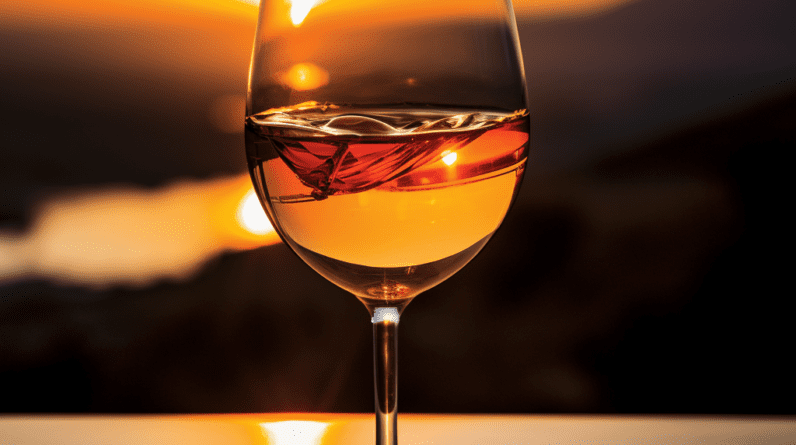
Dive into winter’s embrace with a glass of white wine in hand.
Let’s uncover why the allure of winter whites is growing and how you can savor them during the frosty season.
Imagine this: a gentle snowfall outside, you, nestled near a roaring fireplace, and a glass of pristine white wine reflecting the flames.
While summer wines refresh, winter whites cast a spell of warmth and intimacy.
Reds have traditionally ruled the winter roost.
Yet, white wines are now claiming their frosty throne.
This shift is powered by white wines that are as robust and flavorful as their red counterparts, seamlessly pairing with hearty winter dishes.
Choosing the right white wine
When hunting for that perfect winter white, focus on strong flavors, a kick of acidity, and an alcohol content that can stand up to rich winter dishes.
From sumptuous pot roasts to creamy desserts, the right wine can turn a meal into a memory.

Winter is synonymous with comfort foods.
The ideal white wines not only stand alongside these dishes but elevate them.
Whether your table boasts smoked salmon, spicy sausages, or decadent pies, there’s a white wine waiting to raise the culinary bar.
Serving white wine
Not all white wines should be chilled to the bone.
Over-chilling mutes the flavors and aromas, robbing you of a richer experience.
To truly appreciate your winter white, serve it between 43-55 degrees Fahrenheit.
The ideal temperature varies with the type of wine.
Sparkling wines, like Champagne, dazzle at 43-50 degrees, while full-bodied whites, such as Chardonnay, demand 50-55 degrees for a full flavor profile.
Looking for that perfect white wine glass?
Spotlight on Stellar Winter Whites
Oaked Chardonnay
When it comes to white wines for winter, oaked Chardonnay stands out as a classic choice.
Chardonnay boasts a unique structure and roundness that provide a luxurious, full-bodied mouthfeel, making it a perfect companion for the cold season.
To truly elevate your winter experience, opt for a Chardonnay that has undergone oak aging (not all Chardonnays do).
This aging process imparts a concentrated flavor profile, offering a symphony of rich and nuanced notes.
Riesling
Germany’s gift to the wine world, Riesling, with flavors reminiscent of green apples and apricots, it’s a versatile companion to numerous winter dishes.
Gewurztraminer
Characterized by its gold-coppery shade, Gewurztraminer serves up subtle sweetness with hints of citrus and floral notes.
It’s the ideal partner for everything from pumpkin treats to Crème Brûlée.
Chenin Blanc
With a light body, Chenin Blanc tempts with notes of orange and toasted almond.
It’s a versatile player, pairing wonderfully with glazed pork or custard-based desserts.
Pinot Gris
Hailing from the Pacific Northwest, Pinot Gris presents a tangy profile with lime and green apple notes.
Spice up your winter meals with this aromatic white wine.
Sparkling Wine
Don’t overlook the versatility of sparkling wine when curating your winter wine selection.
Sparkling wine’s inherent qualities make it a valuable addition to your winter table.
Its high acidity acts as a palate cleanser, cutting through the richness of the heartier, fattier foods that frequently grace our winter menus.

Ice Wine
When you’re seeking the ultimate winter indulgence, ice wine beckons.
Enhancing everything from fried dishes to desserts, it’s a delightful end to any winter feast.
The best winter wine is deeply personal.
Guidelines might steer you, but let your palate be the true guide.
Embrace winter’s magic and embark on a vinous adventure. Here’s to chilly nights warmed by impeccable white wines!
Decanting your white wine to give it more air?
FAQ:
Q: What temperature should I serve my winter white wine?
A: To enjoy your winter white wine fully, aim for a serving temperature between 43-55 degrees Fahrenheit.
Champagne and sparkling wines are best served between 43-50 degrees, while full-bodied varieties like Chardonnay shine between 50-55 degrees.
Q: Can you recommend a white wine for a spicy winter dish?
A: Certainly! Pinot Gris, with its punchy acidity and fruity flavors of lime and lemon, pairs wonderfully with spicy dishes like Peking duck and flavorful curries.
Q: Which white wine complements desserts in winter?
A: Gewurztraminer, with its mildly sweet profile and notes of citrus and floral flavors, is an excellent choice for pairing with light winter desserts like custard tarts and Crème Brûlée.
Q: Are there any ice wines you recommend for winter?
A: Absolutely! Ice wines are known to enhance the flavors of many winter treats, from fried foods to chocolate fudge and fruit pies.
Explore the world of ice wines to find the one that complements your winter delights best.
Enjoy your winter wine journey, and may you discover the perfect white wine to warm your heart during the chilly season. Cheers!




